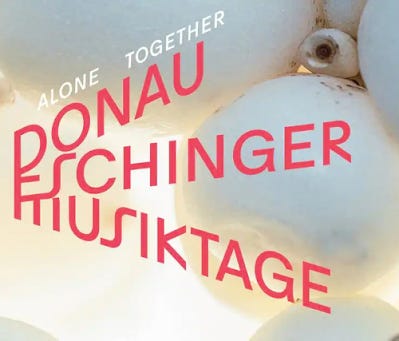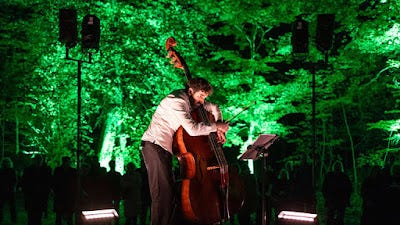[Extended cut of a review forthcoming in The Wire.]

A bastion of New Music for over one hundred years, the Donaueschinger Musiktage continues to make its way into the twenty-first century as that century reaches its quarter-way point. Along the way, many questions; and perhaps, some answers. Taking place before I arrived was an early concert by double-bassist Florentin Ginot in works by Rebecca Saunders and Clara Iannotta, though I caught him on Saturday night in an outdoor performance in the ‘enchanted forest’ setting of the Schlosspark, the trees framing another glade of speakers which projected creaking, woody electronics which merged environmental and virtual sound in pieces by Carola Bauckholt and Lucia Kliger. At one point, the sound of a passing train appeared to come from the speakers before we saw its lights speeding past the glade; at another, I could have sworn I heard owl hooting through the trees, only to look up and see Ginot rubbing on a string.

I also missed Enno Poppe’s hour-long piece for ten drumkits, Streik, while somewhere between the bus stop and the freeway, but the festival’s association with radio station Südwestrundfunk (SWR) ensures that virtually all the music is broadcast, enabling a listen-through on return. Much of the work’s play with spatialisation—as well as the visual spectacle of ten drummers—is lost encountering the music this way, but, on this purely audio evidence, it effectively negotiates between stuttering announcements and raucous clatter, and retaining interest for its hour-long running time is no mean feat. (Though Poppe’s claim in the programme notes that an ensemble of this size “needs a composer” arguably overlooks the work of percussion ensembles not controlled by composers—albeit ones not necessarily operating in the frame of New Music. Take Max Roach’s M’Boom for a start. Quiet as it’s kept, the Black avant-garde was there well over half-a-century ago.)
Between the big orchestral concerts held on the Friday and Sunday in the Baarsporthalle, a gymnasium temporarily converted to concert hall, were works for smaller forces, though one would be hard put to describe them as “chamber music” in anything but name. In a smaller gymnasium next door, earplugs were handed out for a Friday night concert of the late Phill Niblock’s final compositions—perhaps a first for the festival. Neil Leonard’s programme note beautifully describes Niblock’s woodwind pieces as “something akin to an Ellington chord [...] sustained beyond the limits of a single player’s breath”. That was heard here in BLK + LND, a duo for Leonard, on bass clarinet, and double-bassist John Eckhardt, along with the ever-present drones of along with the ever-present drones of Niblockian electronics. As the audience sprawled on the floor, Leonard moved his way through them in an exploration of spatial effects, while Eckhardt and the speakers formed fixed points around which to anchor the sound. In Biliana, a solo work for Biliana Voutchkova, voice and violin united to take on a timbre that seemed to draw on folk musics. Niblock’s music is a kind of return to basic principles—the combination of unison tones, the drone, the open string—in ways that both abstract them and render them palpably material, vibrating in a kind of small-scale sublime. He will be missed.
The next morning, amidst the more high-tech surroundings of the Donauhalle, Mark Andre’s hour-long selig ist...followed traces of mourning. The work was written in memory of a friend’s child, and includes samples from Berlin’s Charité Hospital and the Tränenpalast, or ‘palace of tears’, at Friedrichstraße, where families from either side of the Wall would say tearful farewells. In concept and instrumentation, there were resonances with Nono’s …Sofferte onde serene, but whereas that work’s tape part is often rough-edged and palpably physical in its transformation of Maurizio Pollini’s piano playing, the electronics here functioned more like a sort of additional, infinitely-detailed sustain pedal to Pierre-Laurent Aimard’s piano. In the afternoon, the ensemble lovemusic offered chamber works by Kari Watson, Hannah Kendall, David Bird, and Laura Bowler that were, as Bird put it, in various ways “pop-facing”. Amidst taped interludes featuring an old-fashioned radio as a prop, electronics functioned here to explore what the programme notes (via Bachelard) termed “the dialectics of inside and outside” in various ways. Perhaps most effective, though, was the use, in a work from Kendall’s tuxedo series, of an older technology, that of multiple music boxes, containing snippets of hymns, spirituals and works from the classic repertoire, history over-layered in a kind of haze. (It was through the premiere of Kendall’s large-scale work shouting forever into the receiver at Donaueschingen a couple of years ago that I first came across her work, in which a rigorous historical consciousness is profoundly allied to aesthetic experimentation in ways that feel especially vital.) Meanwhile, across the road in a small cinema, a beautifully understated film by Sebastiano d’Ayala Valva depicted the rehearsals for Occam Ocean Cinquanta, the orchestral work by Éliane Radigue and co-composer Carol Robinson premiered at last year’s festival, further suggesting ways in which traditional ideas of the ensemble—whether those concern instrumentation, the role of improvisation, or the development of pieces along ‘narrative’ lines—continue to be interrogated in search of new ways of conceptualizing music itself.
Radigue’s was the big opening piece at last year’s festival. Opening the Friday night orchestra concert this time was a very different work, Simon Steen-Anderson’s Grosso, featuring the group Yarn/Wire and a gigantic Leslie speaker. As its title implies, the piece is a kind of concerto grosso, retaining the format of the concertino group within the broader mass of the orchestra, but without necessarily treating that group soloistically. Over its forty-something minutes, the piece worked through repertoire of lightly ironized gestures—among them, vibraphone descents that might have accompanied a flashback dissolve or a sci-fi cartoon, and passages for multiple harmonicas—in various configurations. Audience response was certainly positive, and there was a lot of intricate texture, but there was something about its surface I found off-putting: a playfulness that felt oddly joyless, a music in perpetual quotation marks or parentheses. Pascale Criton’s Alter similarly questioned the frames in which we hear music, but in ways that felt more closely related to the question of a more deeply shared experience. As soloist, the magisterial Juliet Fraser was set amidst a sea of orchestral microtones, at first singing fractured syllables and consonants on the borders of language, and then an English-language text she’d herself written about pandemic isolation, ending with a plea for collective listening. A surprising and effective shift to intimacy, this conclusion functioned to gently break the third wall—or at least, to gently crack it—not as a magic trick or a stock alienation effect, but in ways that sparked welcome reflection.




